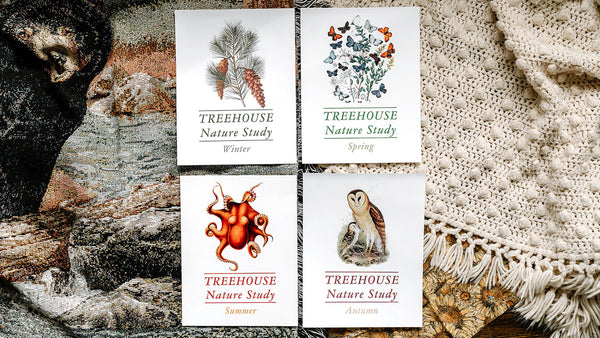In my homeschool, part of what I hold near to my heart is being able to live and enjoy the seasons and the learning they offer my children throughout the year. For years we have implemented nature study as a lens for exploring many different academic subjects, along with creative projects and nature play. We have learned so much by engaging with the outdoors and all it has to offer.
I love doing this in our Morning Time in a more formal way through Treehouse Nature Study, but I also want to leave space for interest-led learning. With the total solar eclipse coming up, I knew it would be worth pivoting our studies and learning all we could about this incredible, once-in-a-lifetime event.
This year, I am so excited my family is planning a solar eclipse expedition to Indiana. We will visit family and view the eclipse. Before going, we will spend some time preparing our minds for what we will see and experience.

Above: Moon week from Treehouse Nature Study: Autumn
If you are looking for ways to learn about the upcoming total solar eclipse, teach your children about the solar eclipse, or special things to do as the solar eclipse approaches, this post is for you!
In this blog post:
- What is a solar eclipse?
- How to watch the solar eclipse
- Activities to watch the solar eclipse
- Favorite children’s books for the solar eclipse
- Field trips for the solar eclipse
- Snack ideas for solar eclipse
- Total solar eclipse learning activities [FREE Unit Study]
What is a solar eclipse?

A solar eclipse is an event that occurs when the Moon passes between the Earth and the Sun. During a solar eclipse, the Moon will partially or completely block the Sun. When the Moon is positioned between the Earth and the Sun, it casts a shadow on the Earth. The shadow on the Earth blocks the daylight and causes darkness to occur.
A solar eclipse happens between two and five times per year and is only available to see in a limited area at a given time.
During a total solar eclipse, the Moon blocks the Sun completely. This depends on the distance between the Earth, Moon, and Sun at any given time during their orbits. Even though the Moon is smaller than the Sun, when the Moon is positioned closer to the Earth, it will appear larger. A total solar eclipse occurs when the Moon passes between the Earth and the Sun while the Moon’s apparent size is equal to, or bigger than, the Sun.
The solar eclipse takes about three hours, but the moment of totality happens when the Sun’s light is blocked completely, lasting for up to six minutes.
Types of solar eclipses
A total solar eclipse is when the light of the Sun is completely blocked by the Moon. You can only view the total phase of the solar eclipse if you are in the direct path. If a solar eclipse is total at any given point of the Earth, it is called a total solar eclipse.
An annular solar eclipse is when the Moon crosses the path of the Sun, but the Moon appears smaller than the Sun. This eclipse is more common and is called a 'ring of fire’ because the light of the Sun will appear as a bright ring around the Moon.
A partial solar eclipse takes place anytime the light of the Sun is only partially blocked by the Moon. During this time, only a portion of the Sun is visible.
Solar eclipses only occur around the new Moon phase because of how the Earth, Sun, and Moon align during that time.
Related: Calendar and Weather Charting for Kids
Total solar eclipse on April 8, 2024

The April 8, 2024 eclipse will be a total solar eclipse. During a total solar eclipse, the Moon moves between the Earth and the Sun, completely blocking the Sun. All of the United States will experience a partial solar eclipse. The total solar eclipse will be visible along the eclipse path, which crosses central Mexico, parts of Texas, Oklahoma, Arkansas, Missouri, Kentucky, Illinois, Indiana, Ohio, Pennsylvania, New York, Vermont, New Hampshire, Maine, and southern Canada.
Research what time you can view the total solar eclipse from your city. If your state falls in the total eclipse path, check out this eclipse directory.
It will be another 20 years before a total solar eclipse is viewable from the United States.
How to watch a total solar eclipse
Eye Safety
It is never safe to look at the Sun directly without specialized solar eye protection. You should never look at the Sun through a camera lens, telescope, binoculars, or any other device. The concentrated solar rays will burn through the filter and cause serious eye injury.
You can look at the Sun directly with ISO-certified eye protection such as wearable eclipse glasses or handheld solar cards. These products reduce the sunlight to safe levels to avoid eye injury. Children should always be supervised when wearing solar eye protection. Do not use solar eye filters with a camera lens, telescope, or other devices.
Indirect viewing
A convenient and safe way to view the eclipse is through indirect viewing. You do not need any special equipment to do this. You can indirectly view a solar eclipse with the shadows of everyday household objects. To do this, you turn your back to the Sun and let the Sun shine through an object such as your outstretched hands, the leaves of a tree, or a household item with gaps such as a colander or slotted spoon. During the partial phases of the solar eclipse, instead of the Sun shining fully through these objects, the Sunlight will shift and project small shapes based on the Moon’s position, revealing the Sun’s crescent shape.
Make a pinhole projector
Another project you can do to indirectly view the solar eclipse is to make a pinhole projector. Remember, it is never safe to look at the Sun directly, even through a tiny pinhole projector. Follow this NASA tutorial on how to make a pinhole projector from a box such as an empty cereal box or tissue box.
Fun activities for learning about the solar eclipse

Children’s books about solar eclipses, the Moon, the solar system, and more!
Fiction
- A Few Beautiful Minutes: Experiencing a Solar Eclipse by Kate Allen Fox
- Papa, Please Get the Moon for Me by Eric Carle
Non-Fiction
- The Astronomy Books: Big Ideas Simply Explained by DK Big Ideas
- The Mysteries of the Universe: Discover the Best-Kept Secrets of Space by Will Gater (DK Children's Anthologies)
- Eclipse: How the 1919 Solar Eclipse Prove Einstein’s Theory of General Relativity by Darcy Pattison
- The Moon Book by Gail Gibbons
- I Am the Moon: A Book About the Moon for Kids by Rebecca and James McDonald
- I Am the Sun: A Book About the Sun for Kids by Rebecca and James McDonald
- The Moon Seems to Change by Franklyn Mansfield Branley
- What the Moon is Like by Franklyn Mansfield Branley
- What Makes Day and Night by Franklyn Mansfield Branley
Reference
- The Julia Rothman Collection: Farm Anatomy, Nature Anatomy, and Food Anatomy
- Moon week from Treehouse Nature Study: Autumn
Field trip ideas
Visit a planetarium, observatory, science center, astronomy center, or space center to learn more about the solar system and more.
Check out the NASA event page and this site to search solar eclipse events in your area.
Related: 3 Reasons to Try Family Backpacking
Solar Eclipse Unit Study [FREE Download]
Whether you dedicate time to learning about the solar eclipse or just want to catch a glimpse the day of, this Charlotte Mason-inspired unit study is a fun way for children to document their findings surrounding the eclipse event.
This free download includes:
- Scientific Observation Reading and Writing Prompt
- Solar Eclipse Activity Checklist
- Poetry Study
- Art Study
- Reference List
My hope is that these activities amplify your experience as you learn about this unique event! Follow the link below to download your FREE Solar Eclipse Unit Study.
FREE DOWNLOAD: Solar Eclipse Unit Study
Related: Poetry in Your Homeschool: Why and How? and Picture Study in Your Homeschool: Why and How?
Snacks and recipes
Whether you are viewing the total solar eclipse with family, friends, or your homeschool co-op community, it is always fun to have a few themed snacks or treats to mark the occasion. Here are some ideas that look fun:
- Black and White Cookies
- Eclipse-themed Snack Board
- Eclipse Sugar Cookies
- Use circle-shaped snacks like Cheerios (or other "o" shaped cereal), banana chips, M&Ms, and more to make an eclipse-themed trail mix.
- Make sandwiches using crescent-shaped croissant rolls
- Astronaut Pudding with freeze-dried fruit
Online resources for learning about the solar eclipse
- What is a Solar Eclipse? (YouTube)
- Total Solar Eclipse Virtual Field Trip (YouTube)
- Why the 2024 Solar Eclipse is Such a Big Deal (YouTube)
- Different Ways to Safely View a Solar Eclipse (YouTube)
- Track the Eclipse Path (NASA)
- Catch NASA's live stream of the total solar eclipse (NASA)
- Solar Eclipse Timer App
- Make a scientific model of a solar eclipse (YouTube)
- How to draw a solar eclipse (YouTube)
Study nature in-depth with Treehouse Nature Study
If your family enjoyed learning about the solar eclipse, consider exploring more themes of nature and science with Treehouse Nature Study.
Treehouse Nature Study is a seasonal nature study curriculum designed with family-style learning in mind. It is a gentle guide meant to invite various ages to connect with each other and the world around them through living books, nature notebooking, hands-on projects, and beauty subjects such as poetry, picture study, and folk songs.
Related: Six Core Values of Treehouse Nature Study
From preschool through upper middle school, it appeals to every age and is easily used with multiple ages at the same time.
The 52-week curriculum is a great fit for your preschool or kindergartener’s core curriculum or your whole family’s home education Morning Time and Nature Study. It also provides supplemental work for your children’s language arts through poetry memorization, recitation, copywork, and notebooking.
FREE DOWNLOAD: Try a free week of Treehouse Nature Study
For specifics on the Moon featured throughout this study, check out Moon week from Treehouse Nature Study: Autumn.
Are you planning to view the total solar eclipse? Let me know in the comments below.


![Total Solar Eclipse Educational Resources and Activities [+ FREE Unit Study]](http://treehouseschoolhouse.com/cdn/shop/articles/IMG_3511.jpg?v=1711566100&width=3000)





